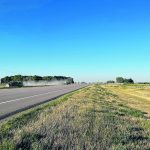The road, also known as the Crowsnest Highway, is often billed as one of Canada’s most significant agri-food corridors
The pledge to twin a portion of Alberta’s Highway 3 between Taber and Burdett starting this year was made with plenty of fanfare by two Alberta premiers over the past three years. However, that commitment, part of a more than decade-old push to twin the stretch of highway between Medicine Hat and Lethbridge, has quietly […] Read moreTag Archives Alberta — page 3

Water crisis deepens for southern Alta. irrigators
Liner repairs to the Lethbridge Northern Irrigation District’s canal system continue, but shortage becoming desperate
The situation for those using water supplied by the Lethbridge Northern Irrigation District in southern Alberta is becoming desperate. The latest information from LNID does not bode well for irrigation farmers, as emergency repairs continue on a liner that feeds the canal system. It runs from west of Fort Macleod to east of Picture Butte. […] Read more
Alberta irrigation springs a leak

Oil, gas love affair may threaten ag

Wildfire preparation requires thorough evacuation plan
Producers need to know ahead of time how and where they will move their livestock if a dangerous situation occurs
From the moment an individual decides to have livestock on their land Mikki Shatosky, emergency management co-ordinator for the Animal Health Emergency Management (AHEM) organization, said they must start thinking about how to deal with emergencies, whether it's weather or disease related.
Resentment builds in Alta. over wildfires

Oil and gas issues are no-shows on Alberta election radar
Landowners continue to worry about abandoned wells, but the topic has barely been addressed during the campaign
Millions of outstanding tax payments have been written off by rural municipalities with hundreds of millions owing. Landowners have seen surface lease payments unilaterally diminished and, in many cases, not paid at all.
Loss of habitat threatens snake population
Those working to preserve the region’s snakes say human development is the biggest threat, but this can be managed
Sherri Monk, owner of Snakes on the Plains, said human development is the biggest threat to Alberta’s snake population.
Farm couple insists on staying put
Vic and Winnie Rowley are in their mid- and late 80s; they want to stay on their central Alberta farm as long as they can
CLIVE, Alta. — At 88 and 86 years old, Vic and Winnie Rowley have no intention of retiring and moving off the farm. “I like to go to town in the morning for coffee and that’s it,” said Vic, from his farm north of Clive, Alta. “I don’t think I’d like living in town. It […] Read more






